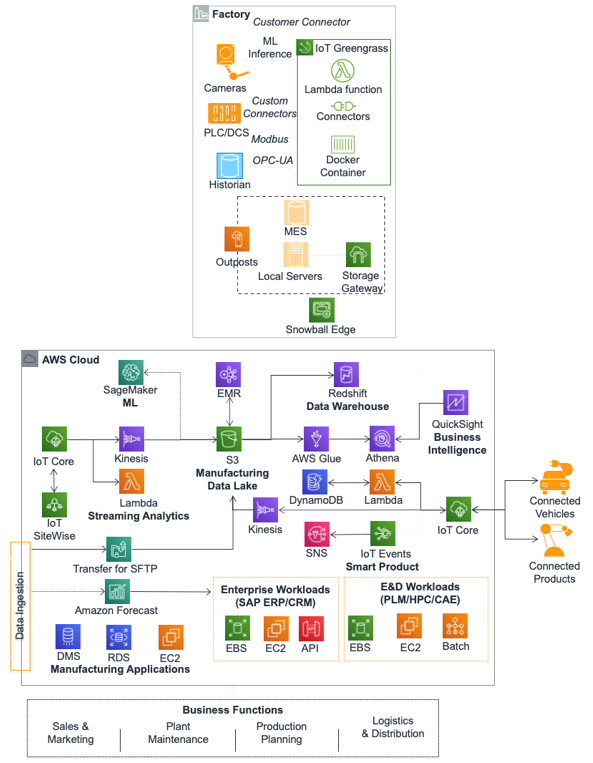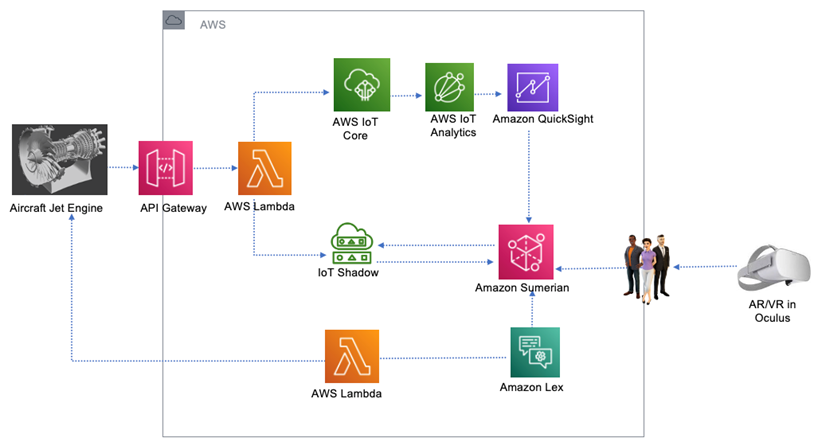

The Internet of Things in Solutions Architecture
source link: https://dzone.com/articles/the-internet-of-things-in-solutions-architecture
Go to the source link to view the article. You can view the picture content, updated content and better typesetting reading experience. If the link is broken, please click the button below to view the snapshot at that time.

The Internet of Things in Solutions Architecture
Information modeling and event management are critical for detecting changes across complex industrial systems. Industrial IoT solutions can address this.
Join the DZone community and get the full member experience.
Join For FreeAs internet connectivity increases, an increasing number of small devices now exist with small memory and compute capacities. These sensors connect various physical entities, such as your home alarm, thermal sensors, and car. The data from millions of these connected devices needs to be collected and analyzed. For example, weather data collected from multiple sensors can be utilized to forecast weather for wind energy and farming. There are billions of connected devices in homes, factories, oil wells, hospitals, cars, and thousands of other places that are fueling digital transformation, generating huge volumes of data and growing exponentially.
As IoT has become very common in the manufacturing industry for handling machine data and optimizing production, the concept of Industrial IoT (IIoT) was developed. Let’s learn more about this now.
This article is excerpted from Solutions Architect's Handbook, Second Edition, by Saurabh Shrivastava and Neelanjali Srivastav.
Building an Industrial IoT Solution
Industrial customers seek to gain insights into their industrial data and achieve outcomes such as lower energy costs, detecting and fixing equipment issues, spotting inefficiencies in manufacturing lines, improving product quality, and improving production output. These customers are looking for visibility into operational technology (OT) data from machines and product life cycles (PLCs) systems for performing root cause analysis (RCA) when a production line or a machine goes down. Furthermore, IoT improves production throughput without compromising product quality by understanding micro-stoppages of machinery in real time.
Data collection and organization across multiple sources, sites, or factories are challenging to build and maintain. Organizations need a consistent representation of all their assets that can be easily shared with users and used to build applications, at a plant, across plants, and at a company level. Data collected and organized using on-premises servers is isolated to one plant. Most data collected on-premises is never analyzed and thrown away due to a lack of open and accessible data.
The best practice is to extract data from databases commonly found in industrial facilities, transfer it to the centralized storage in the data center or cloud, and structure it to be easily searchable by users and applications. On top of that data, you can derive common industrial performance metrics such as Overall Equipment Efficiency (OEE). Monitor operations across multiple industrial facilities and build applications to analyze industrial equipment data, prevent costly equipment issues, and reduce gaps in production. To design industrial IoT architecture, you need to perform the following steps:
- Ingest data from industrial equipment, data servers, and historian databases
- Collect, organize, and analyze industrial data at scale
- Read data from onsite equipment using industrial protocols and standards such as OPC-UA, Modbus, and EtherNet/IP
- Create visual representations of physical assets, process equipment data streams, and compute industrial performance metrics
- Access local dashboards to view real-time and historical equipment data, even when temporarily disconnected from the internet
- Consume asset data to create local or cloud applications that optimize factory output quality, maximize asset utilization, and identify equipment maintenance issues
To address the growing need for Industrial IoT, cloud providers such as AWS provide managed services like AWS IoT SiteWise, which can collect data from the plant floor with a local gateway, structure and label that data, and generate real-time KPIs and metrics to help make better data-driven decisions.
Data is collected from equipment across all sites during ingestion and sent to services like AWS IoT SiteWise from AWS IoT Core and through PUT APIs. Then it creates model assets that are virtual representations of physical assets. The managed service helps to digitize, contextualize, and model entire production environments without customers having to maintain their infrastructure. Customers can represent complex equipment hierarchies using rich information modeling.
Event management is critical for detecting changes across complex industrial systems. There is a need to continuously monitor data from your equipment to identify their state, detect changes, and trigger the appropriate responses when changes occur.
Let's look at an IIoT reference architecture to bring all of the pieces together.
Connected Factory IoT Architecture
The connected factory (CF) solution is designed to bring together capabilities to transform manufacturing operations. CF makes it easy for customers to unblock data from their legacy systems, visualize the data in near real time, perform deeper analytics to optimize operations, and improve productivity and asset availability. The key focus for the CF offering is to commoditize industrial data collection and develop repeatability. Let's look at the following diagram, which demonstrates IoT architecture for implementing connected factory solutions on the AWS Cloud platform.

Figure 1: Connected Factory architecture in the AWS Cloud
As shown in the preceding diagram, AWS IoT Greengrass is deployed at the edge of the factory floor to collect equipment data and other data ingested from servers at the facility. Data lands in the AWS Cloud through IoT Core, and IoT Sitewide helps to build a model of physical devices. Data from various facilities is stored in Amazon S3 to build a manufacturing data lake that can be further loaded in Redshift for Datawarehouse and processed through the ETL pipeline using AWS Glue and ad hoc queries performed using Amazon Athena. Finally, you can use QuickSight to visualize data for business users.
Streaming data is transformed and processed and provides input back to product equipment or shipment information to the vehicle. You can also see ML components perform production forecasting and post that data in ERP and PLM systems to optimize production efficiency. ML is performed at the edge to understand and alert on equipment heath to reduce downtime.
When it comes to training staff on equipment and creating a simulation, adding a visualization layer makes sense. This is now possible with the availability of AR/VR (augmented reality/virtual reality). That's where digital twins come into the picture. Let’s learn more details about digital twins.
Implementing a Digital Twin
A digital twin is a digital replica of a physical machine. In a digital twin, you build a virtual representation of the machine using AR/VR to visualize a real-time data overlay. It helps to see real-time operational and health data, combined with machine learning; you can draw insights from real-world behavior such as performing a proactive maintenance model. A digital twin can be handy for simulating what-if scenarios to determine the optimum KPI for the machine, and building immersive education and training to handle the equipment.
A digital twin continuously collects real-time data using IoT and can control the machine’s operation from a digital replica. It provides an immersive experience of the living model of a machine and helps with early warning, prediction, and optimization. A digital twin performs the following tasks shown in the diagram below:

Figure 2: Modeling the mind of the machine with a digital twin
As shown, a digital twin manages a machine by:
- Monitoring:The digital twin collects and analyzes the data by replicating a digital copy in the virtual world. Machine telemetry data can come from sensors ingested by the cloud. The factory floor data can be ingested by building an API wrapper around the on-premises applications.
- Analyzing:To build a digital replica, you can use popular AR/VR technology such as Microsoft HoloLens, Amazon Sumerian, or Oculus. You can create a data overlay on top of the digital replica to show how data flows from various sensors. Further analytics can be performed. To build data visualization and search capabilities, you can use tools like Amazon OpenSearch and Quicksight. The digital twin can be controlled over voice using AI-powered services. ML capabilities can be implemented to train, tune, and deploy the ML model.
- Acting:As you get data insights and predictions, you can take the required action by sending messages back to the operations team. You can notify operational applications by creating automated maintenance tickets for staff on the ground. AWS IoT Core can take your message and apply direct operations to the machine. If a cooling fan is running abnormally or getting hotter than expected, you can stop the machine directly from the digital twin.
Let’s take a reference architecture of a digital twin for an aircraft jet engine, as shown in the following diagram. Here, you collect engine temperature and speed data in real time using IoT sensors and show data overlays in a digital engine replica to gain insights and take action.

Figure 3: Digital twin architecture for an aircraft jet engine
As shown in the preceding diagram, temperature and engine speed data were sent from a jet engine to the cloud. AWS IoT Analytics performed data processing to collect insights into the sensor data collected and visualized information in the Amazon QuickSight dashboard. The jet engine’s current state is maintained using Device Shadow, so if sensors go offline, you can still perform simulations. Here, a jet engine digital replica was created using the Amazon Sumerian virtual reality platform and deployed in Oculus. Using the Amazon Lex AI service, you can start/stop the actual engine with your voice or a message.
Summary
Industrial IoT is becoming very popular for optimizing production and reducing operational downtime. In this article, you have learned how to address IIoT operations at scale. You also learned about connected factory IoT architecture and its functioning in detail.
Combining AR/VR technology with IoT provides an immersive experience. You also learned about the digital twin concept, where a virtual replica of a physical machine gets created with real-time data overlay. You also considered a jet engine digital twin architecture with different components to monitor, analyze, and act using the digital twin model.
This article is excerpted from Solutions Architect's Handbook, Second Edition, by Saurabh Shrivastava and Neelanjali Srivastav.
Recommend
About Joyk
Aggregate valuable and interesting links.
Joyk means Joy of geeK